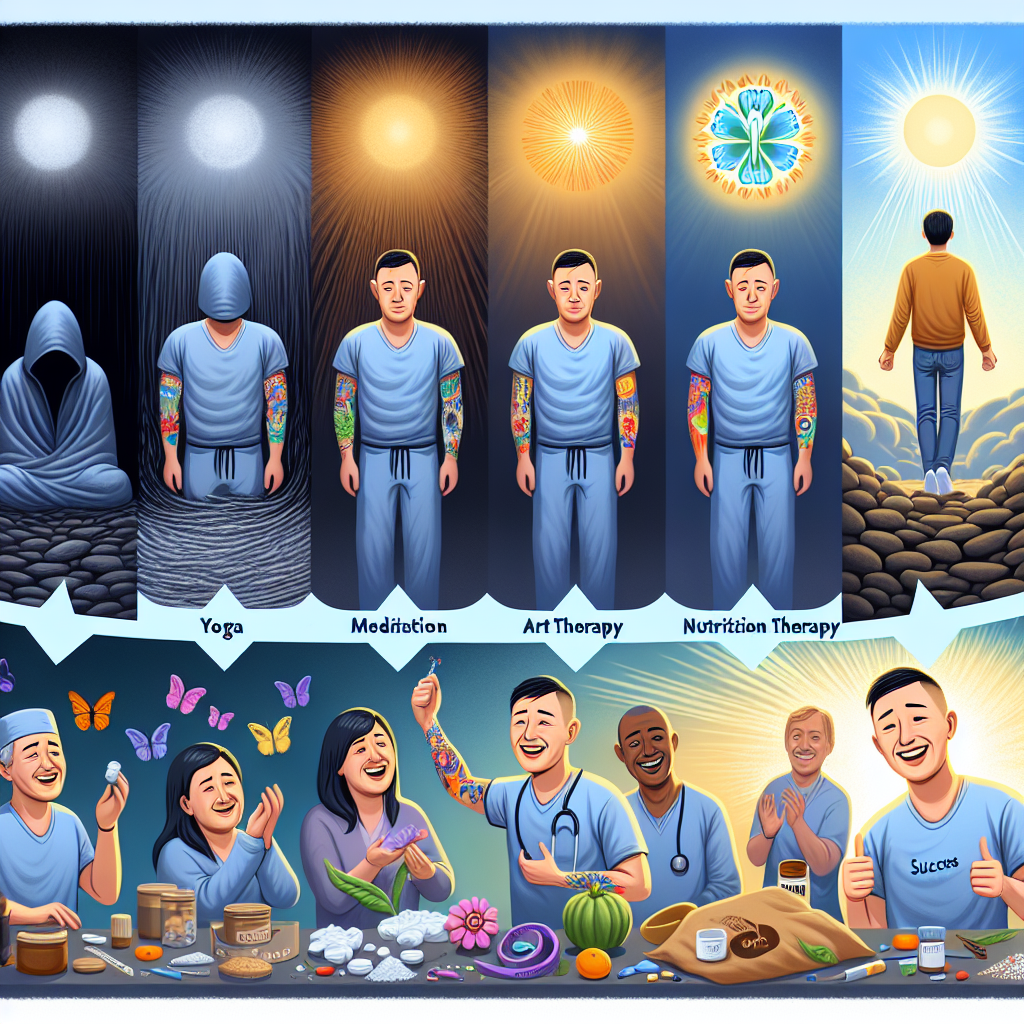-
Table of Contents
“Discover the Path to Recovery: Unveiling the Most Effective Therapies in Heroin Rehab”
Introduction
Heroin addiction is a severe and complex condition that requires a multifaceted approach to treatment. The most effective therapies in heroin rehab typically include a combination of medication-assisted treatment (MAT), behavioral therapies, and support systems. MAT often involves the use of medications such as methadone, buprenorphine, or naltrexone to help manage withdrawal symptoms and reduce cravings. Behavioral therapies, such as cognitive-behavioral therapy (CBT) and contingency management, aim to modify the patient’s attitudes and behaviors related to drug use and increase healthy life skills. Additionally, support systems like group therapy and 12-step programs provide a community of peers who understand the challenges of addiction and can offer encouragement and accountability. Integrating these therapies creates a comprehensive treatment plan that addresses the physical, psychological, and social aspects of heroin addiction, thereby increasing the likelihood of successful recovery.
Cognitive Behavioral Therapy: A Key Component in Heroin Rehab
Cognitive Behavioral Therapy (CBT) has emerged as a cornerstone in the treatment of heroin addiction, offering a structured and effective approach to rehabilitation. This therapeutic method is grounded in the understanding that our thoughts, feelings, and behaviors are interconnected, and that by altering negative thought patterns, individuals can change their behaviors and emotional states. In the context of heroin rehab, CBT provides a powerful tool for individuals to regain control over their lives and break free from the cycle of addiction.
One of the primary reasons CBT is so effective in heroin rehab is its focus on identifying and challenging the distorted thinking patterns that often accompany addiction. Heroin addiction can lead to a range of cognitive distortions, such as black-and-white thinking, catastrophizing, and overgeneralization. These distorted thoughts can perpetuate feelings of hopelessness and helplessness, making it difficult for individuals to envision a life without heroin. Through CBT, individuals learn to recognize these harmful thought patterns and replace them with more balanced and realistic perspectives. This cognitive restructuring is crucial in helping individuals develop a more positive and empowered mindset, which is essential for long-term recovery.
Moreover, CBT equips individuals with practical coping strategies to manage the triggers and cravings that are an inevitable part of the recovery process. Heroin addiction often involves deeply ingrained behavioral patterns that are triggered by specific situations, emotions, or environments. CBT helps individuals identify these triggers and develop personalized coping mechanisms to deal with them effectively. For instance, someone might learn to use mindfulness techniques to stay grounded in the present moment, or they might develop a plan to avoid high-risk situations that could lead to relapse. By providing these practical tools, CBT empowers individuals to take proactive steps in their recovery journey.
In addition to addressing cognitive and behavioral aspects, CBT also emphasizes the importance of emotional regulation. Heroin addiction often serves as a maladaptive coping mechanism for dealing with painful emotions such as anxiety, depression, or trauma. CBT helps individuals develop healthier ways to manage these emotions, reducing their reliance on heroin as a form of self-medication. Techniques such as deep breathing, progressive muscle relaxation, and cognitive reframing can be incredibly effective in helping individuals navigate the emotional ups and downs of recovery. By fostering emotional resilience, CBT supports individuals in building a more stable and fulfilling life.
Furthermore, the collaborative nature of CBT enhances its effectiveness in heroin rehab. Unlike some therapeutic approaches that position the therapist as the expert, CBT views the therapist and the individual as partners in the recovery process. This collaborative relationship fosters a sense of trust and mutual respect, which is vital for effective therapy. Individuals are encouraged to take an active role in their treatment, setting goals, tracking their progress, and providing feedback. This active participation not only enhances the therapeutic alliance but also instills a sense of ownership and accountability in the recovery process.
In conclusion, Cognitive Behavioral Therapy stands out as a key component in heroin rehab due to its comprehensive approach to addressing the cognitive, behavioral, and emotional aspects of addiction. By helping individuals identify and challenge distorted thinking patterns, develop practical coping strategies, and regulate their emotions, CBT provides a robust framework for recovery. The collaborative nature of CBT further enhances its effectiveness, empowering individuals to take an active role in their healing journey. Through the transformative power of CBT, individuals can break free from the grip of heroin addiction and build a healthier, more fulfilling life.
The Role of Medication-Assisted Treatment in Heroin Rehabilitation
Medication-Assisted Treatment (MAT) has emerged as a cornerstone in the rehabilitation of individuals struggling with heroin addiction. This approach combines the use of medications with counseling and behavioral therapies, creating a holistic treatment plan that addresses both the physical and psychological aspects of addiction. The effectiveness of MAT in heroin rehab cannot be overstated, as it has been shown to significantly improve patient outcomes, reduce the risk of relapse, and enhance the overall quality of life for those in recovery.
One of the primary medications used in MAT for heroin addiction is methadone. Methadone works by binding to the same opioid receptors in the brain that heroin targets, thereby reducing cravings and withdrawal symptoms without producing the euphoric high associated with heroin use. This allows individuals to stabilize their lives, engage in therapy, and rebuild their relationships and careers. Methadone has been extensively studied and has a long track record of success, making it a reliable option for many patients.
Another effective medication in MAT is buprenorphine, which also targets opioid receptors but with a ceiling effect that lowers the risk of misuse and overdose. Buprenorphine can be prescribed in a doctor’s office, making it more accessible for many individuals. This medication not only helps to manage withdrawal symptoms and cravings but also allows patients to focus on their recovery journey without the constant distraction of physical discomfort. The flexibility and safety profile of buprenorphine make it a popular choice among healthcare providers and patients alike.
Naltrexone is another medication used in MAT, but it works differently from methadone and buprenorphine. Naltrexone is an opioid antagonist, meaning it blocks the effects of opioids at the receptor level. This medication is particularly useful for individuals who have already detoxed from heroin and are committed to maintaining their sobriety. By preventing any potential high from opioid use, naltrexone serves as a powerful deterrent against relapse. Its effectiveness is enhanced when combined with comprehensive counseling and support services.
While medications play a crucial role in MAT, they are most effective when integrated with behavioral therapies. Cognitive-behavioral therapy (CBT) is one such approach that helps individuals identify and change negative thought patterns and behaviors associated with their addiction. Through CBT, patients learn coping strategies, stress management techniques, and ways to handle triggers that may lead to relapse. This therapeutic approach empowers individuals to take control of their recovery and build a healthier, more fulfilling life.
Another valuable component of MAT is contingency management, which uses positive reinforcement to encourage sobriety and adherence to treatment. Patients receive tangible rewards for meeting specific goals, such as attending therapy sessions or passing drug tests. This approach not only motivates individuals to stay on track but also helps to build a sense of accomplishment and self-worth.
Family therapy is also an integral part of the rehabilitation process, as addiction often affects not just the individual but their loved ones as well. By involving family members in therapy, patients can repair damaged relationships, build a supportive home environment, and address any underlying issues that may have contributed to their addiction. This holistic approach ensures that the entire support system is engaged in the recovery process, increasing the likelihood of long-term success.
In conclusion, Medication-Assisted Treatment represents a comprehensive and effective approach to heroin rehabilitation. By combining medications like methadone, buprenorphine, and naltrexone with behavioral therapies and support systems, MAT addresses the multifaceted nature of addiction. This integrated treatment model not only alleviates the physical symptoms of withdrawal but also empowers individuals to make lasting changes in their lives. Through dedication, support, and the right therapeutic interventions, recovery from heroin addiction is not just possible—it is achievable.
Q&A
1. **Question:** What is one of the most effective behavioral therapies used in heroin rehab?
**Answer:** Cognitive Behavioral Therapy (CBT) is one of the most effective behavioral therapies used in heroin rehab, helping patients recognize and change negative thought patterns and behaviors related to their addiction.
2. **Question:** What medication is commonly used in Medication-Assisted Treatment (MAT) for heroin addiction?
**Answer:** Methadone is a commonly used medication in Medication-Assisted Treatment (MAT) for heroin addiction, helping to reduce withdrawal symptoms and cravings.
Conclusion
The most effective therapies in heroin rehab typically include a combination of medication-assisted treatment (MAT), behavioral therapies, and support groups. MAT often involves the use of medications such as methadone, buprenorphine, or naltrexone to manage withdrawal symptoms and reduce cravings. Behavioral therapies, such as cognitive-behavioral therapy (CBT) and contingency management, help individuals modify their attitudes and behaviors related to drug use and increase healthy life skills. Support groups, including 12-step programs like Narcotics Anonymous, provide peer support and a sense of community. An integrated approach that combines these therapies is generally considered the most effective for achieving long-term recovery.



